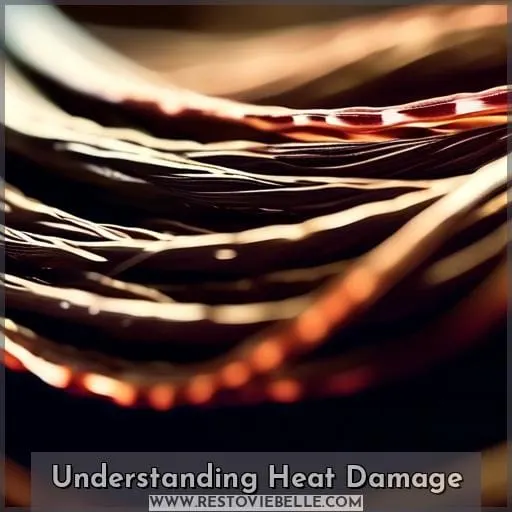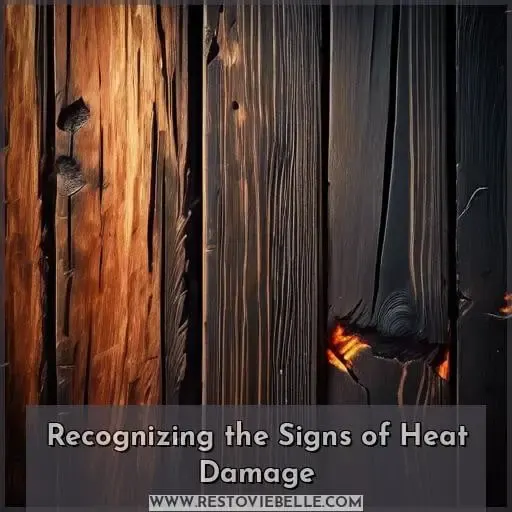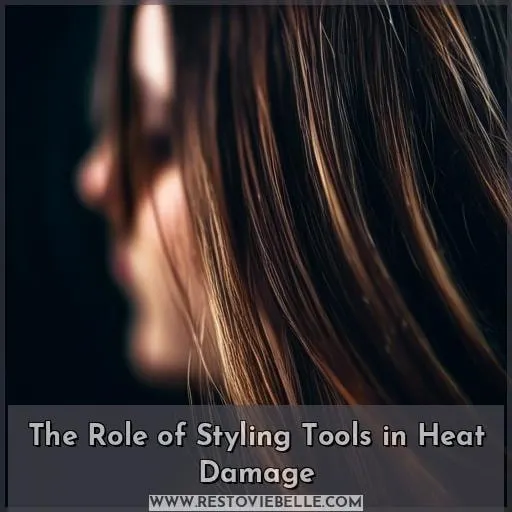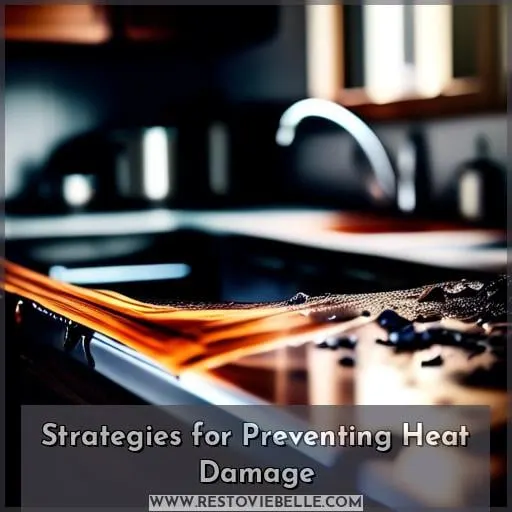This site is supported by our readers. We may earn a commission, at no cost to you, if you purchase through links.
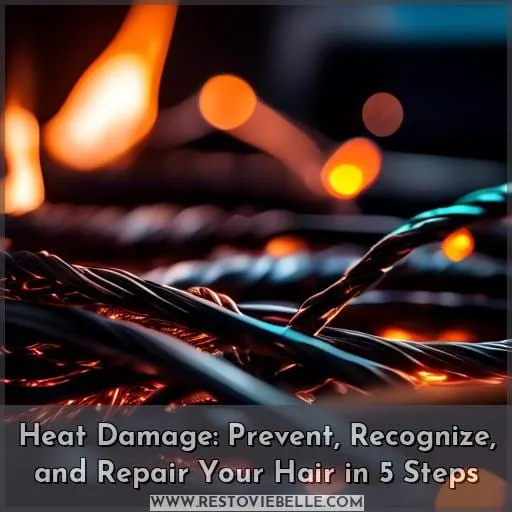
If you’re among the many who’ve felt the sting of dry, brittle strands, you’re not alone.
This guide is your arsenal in the battle for healthy hair, offering insights into prevention, recognition, and repair. You’ll learn how to strike a balance between achieving those perfect styles and maintaining the integrity of your hair.
Embrace the journey towards liberation from damage and mastery over your hair’s health in five practical steps.
Table Of Contents
- Key Takeaways
- Understanding Heat Damage
- Recognizing the Signs of Heat Damage
- The Role of Styling Tools in Heat Damage
- Strategies for Preventing Heat Damage
- Alternatives to Heat Styling
- Frequently Asked Questions (FAQs)
- How does heat damage affect the natural color of hair, and can it accelerate the fading of dyed hair?
- Are there specific hair types or textures more susceptible to heat damage, and how does this vary across different ethnicities?
- Can nutritional deficiencies exacerbate the effects of heat damage on hair, and if so, which nutrients are most important for hair health in this context?
- How does the frequency of heat styling correlate with the severity of heat damage, and is there a safe threshold for heat tool usage?
- In the context of heat damage, how effective are DIY or home remedies compared to professional treatments, and what are some examples of each?
- Conclusion
Key Takeaways
- Heat alters hair’s protein structure, primarily keratin, leading to moisture loss, reduced elasticity, and ultimately, hair damage. Excessive heat can break disulfide bridges and hydrogen bonds, compromising hair integrity, which manifests as dryness, brittleness, increased split ends, and breakage.
- Styling tools such as blow dryers, flat irons, and curling irons can cause significant damage to hair cuticles and strip away moisture. However, technologies like ceramic coating and ionic technology, along with the use of adjustable nozzles and heat protection sprays, can help distribute heat more evenly and minimize damage.
- The balance between styling and maintaining hair health involves understanding the impact of heat on hair, considering hair porosity when choosing heat settings, and embracing natural hair texture whenever possible. Using heat protectants religiously and opting for gentler styling techniques, especially on chemically treated hair, are crucial steps in preventing heat damage.
- Preventative strategies against heat damage include applying heat protectants before using hot tools, selecting the appropriate temperature setting for your hair type (ideally not exceeding 410°F), using deep conditioning treatments to replenish moisture, and limiting overall heat exposure to maintain hair integrity.
Understanding Heat Damage
Understanding the impact of heat on your hair is crucial for maintaining its health and appearance.
Exposing your hair to high temperatures can alter its protein structure, primarily keratin, leading to a loss of moisture and elasticity.
This damage not only makes your hair more prone to breakage but also affects its natural shine and texture, making it look dull and lifeless.
By recognizing these signs early, you can take steps to prevent further damage and start repairing your hair to restore its vitality.
Effects on Hair’s Protein Structure
When you expose your hair to high heat, you’re not just styling it; you’re altering its very core.
The keratin structure that gives your hair its strength and resilience relies on amino acid bonds, including disulfide bridges and hydrogen bonds, to maintain the hair’s integrity.
However, excessive heat can break these bonds, leading to a compromised structure. This doesn’t just affect the appearance of your hair; it impacts its health, making it more susceptible to further damage.
By understanding the delicate balance of forces that keep your hair strong, you can make informed choices about how to care for it, ensuring it remains healthy and vibrant.
Loss of Moisture and Elasticity
When you style your hair with heat, you’re not just shaping it; you’re also stripping away vital moisture, leading to a loss of elasticity.
This can increase your hair’s porosity, making it absorb and release moisture too quickly, which in turn can cause hygral fatigue.
This condition weakens your hair, leaving it prone to breakage and making it harder to maintain your desired look.
To keep your hair’s integrity, it’s crucial to understand the balance between styling and its health.
Recognizing the Signs of Heat Damage
Recognizing the signs of heat damage in your hair is crucial for maintaining its health and beauty.
If you’ve noticed your hair becoming dry and brittle, or if split ends and breakage have become more frequent, it’s likely that heat styling tools are taking a toll on your locks.
These symptoms indicate that the protective cuticle of your hair is compromised, leading to weakened strands that are more susceptible to damage.
Dryness and Brittleness
When you frequently style your hair with heat, you might notice it becoming dry and brittle.
The intense heat from styling tools strips your hair of moisture, leading to a lack of shine and a dull appearance. You might also experience static electricity, making your hair frizzier and harder to manage.
Tangling becomes more common, and detangling can cause further breakage. To keep your hair healthy, it’s crucial to recognize these signs early and take steps to mitigate the damage.
Split Ends and Breakage
Split ends and breakage are telltale signs you’re dealing with heat damage. When you overuse styling tools, your hair’s structure weakens, leading to frayed ends and strands that snap easily.
You might notice your hair feels thinner, with weak roots contributing to this fragility. Frizz, dullness, and tangles become more common, making your hair harder to manage.
Even your scalp can suffer, experiencing irritation from the stress your hair is under. It’s crucial to recognize these symptoms early to prevent further damage and start on the path to recovery.
The Role of Styling Tools in Heat Damage
Styling tools such as blow dryers, flat irons, and curling irons play a significant role in heat damage to your hair. While these tools can help you achieve the look you desire, they can also cause cracks in the hair cuticles and strip away moisture, leading to dryness and breakage.
It’s crucial to find a balance between styling and maintaining hair health, using these tools wisely and protecting your hair with the right products and techniques.
Impact of Blow Dryers, Flat Irons, and Curling Irons
After recognizing the signs of heat damage, it’s crucial to understand the role your styling tools play.
- Temperature Control: High heat settings can alter your hair’s protein structure, leading to dryness. Opt for tools with adjustable temperature to minimize damage.
- Ceramic Coating & Ionic Technology: These features help distribute heat more evenly, reducing the chances of overheating certain spots.
- Adjustable Nozzles & Heat Protection Spray: Use nozzles to direct airflow and always prep with a heat protection spray to shield your strands.
Embrace these tools wisely to maintain your hair’s health and vitality.
The Balance Between Styling and Hair Health
After discussing the impact of heat tools, it’s crucial to find a balance between achieving your desired style and maintaining hair health.
You’re not alone in wanting to look your best, but remember, excessive heat can strip your hair of moisture, leading to dryness and breakage.
To preserve your hair’s integrity, consider the porosity of your strands when choosing heat settings. High porosity hair, for example, is more vulnerable to humidity effects and may benefit from protective hairstyles and lower temperatures.
On the other hand, chemical treatments can alter your hair’s structure, so it’s essential to use styling techniques that minimize damage.
Embrace your natural texture when possible and use heat protectants religiously to shield your locks from the stress of styling.
Strategies for Preventing Heat Damage
To shield your hair from the harsh effects of heat styling, it’s crucial to adopt a proactive approach. Start by applying a heat protectant before using any hot tools; this forms a barrier that slows down heat conduction, safeguarding your strands.
Opting for the right temperature setting is also key—avoid exceeding 410°F to prevent damaging the keratin in your hair.
Additionally, integrating deep conditioning treatments into your routine can replenish moisture and repair damage, ensuring your hair remains healthy and resilient.
Use of Heat Protectants
Continuing from the discussion on the impact of styling tools, it’s crucial to shield your hair with heat protectants. These products form a barrier, safeguarding your strands from the intense heat of dryers and irons.
Look for silicone-based formulas or those with heat-resistant polymers, which excel in sealing moisture and enhancing your hair’s resilience against thermal stress. Leave-in conditioners can also offer an extra layer of protection, ensuring your hair stays hydrated and less prone to damage.
Selecting Appropriate Temperature Settings
To prevent heat damage, it’s crucial to select the right temperature settings for your styling tools.
- Follow temperature guidelines: Fine or damaged hair should be styled at lower temperatures, between 250-340°F, while thicker hair can handle up to 375°F. Never exceed 400°F to avoid severe damage.
- Maintain your tools: Regularly clean your styling tools to ensure even heat distribution and prevent product buildup, which can affect temperature accuracy and hair health.
- Limit heat exposure: Use the minimum heat necessary for your styling technique, and don’t overdo it. Employ protective equipment like heat protectants to shield your strands during styling.
Incorporating Deep Conditioning Treatments
Incorporating deep conditioning treatments into your hair care routine is a game-changer for preventing heat damage. These treatments are packed with deep conditioning benefits, offering a surge of moisture and protein to fortify your hair from the inside out.
Whether you opt for store-bought hair masks or whip up your own DIY deep conditioning concoction, the goal is to replenish lost moisture and elasticity. Regular use of leave-in conditioners and protein treatments can significantly reduce breakage and split ends, leaving your hair looking healthier and more resilient.
Embrace the power of deep conditioning to keep your hair’s health in check, even as you style it to perfection.
Alternatives to Heat Styling
To explore alternatives to heat styling and prevent damage to your hair, consider embracing your natural hair textures and experimenting with heatless styling methods.
You can opt for natural, DIY heat protectants like argan oil, shea butter, coconut oil, avocado oil, grapeseed oil, sunflower oil, and almond oil to safeguard your hair from heat damage effectively.
Remember to use heat tools wisely by selecting the lowest effective heat setting, avoiding overuse of heat styling tools, and reapplying protectants as needed to maintain coverage and protect your hair from potential damage.
Additionally, after heat styling, consider using a nourishing serum or oil to add moisture and further shield your hair from harm.
Embracing Natural Hair Textures
After learning how to prevent heat damage, let’s shift focus to embracing your natural hair textures. This isn’t just about avoiding heat; it’s a celebration of your hair’s unique beauty.
- Importance of Hydration: Keep your curls quenched with moisture-rich products to enhance their natural pattern and shine.
- Protective Hairstyles: Experiment with styles like braids or twists that safeguard your strands while looking chic.
- Air Drying Techniques: Master the art of air drying to define your curls without the frizz, maintaining their health and vitality.
By embracing hair diversity, you’re taking control of your hair’s health and showcasing its natural splendor.
Exploring Heatless Styling Methods
After embracing your natural hair textures, consider diving into the world of heatless styling methods. These techniques not only preserve your hair’s health but also unleash a new realm of creativity.
Experiment with no-heat rollers for gentle waves, or wrap your hair in silk overnight for smooth curls. Bantu knots can sculpt your locks into tight spirals, while twist-outs and braids offer everything from subtle waves to defined curls.
Each method not only spares your hair from heat damage but also empowers you with control over your styling routine, allowing your hair to thrive in its natural glory.
Frequently Asked Questions (FAQs)
How does heat damage affect the natural color of hair, and can it accelerate the fading of dyed hair?
Heat damages your hair’s natural color by breaking down pigments and accelerating the fading of dyed hair, especially when using tools above 302°F.
Protect your color by using heat protectants and avoiding excessive heat.
Are there specific hair types or textures more susceptible to heat damage, and how does this vary across different ethnicities?
Fine, fragile hair faces more frequent flyaways and is particularly prone to heat damage.
Coarse, curly locks often exhibit endurance but may still suffer from styling stress.
Different ethnicities display distinct damage dynamics. For instance, Asian hair typically tolerates heat better than African hair.
Can nutritional deficiencies exacerbate the effects of heat damage on hair, and if so, which nutrients are most important for hair health in this context?
Yes, nutritional deficiencies can worsen heat damage on hair.
Key nutrients include iron, B vitamins, biotin, zinc, vitamin A, vitamin C, vitamin D3, omega-3s, and protein.
They support hair growth, strength, and repair, making your locks more resilient.
How does the frequency of heat styling correlate with the severity of heat damage, and is there a safe threshold for heat tool usage?
Despite what you might think, more heat styling doesn’t always mean better results. In fact, increasing the frequency of heat styling directly correlates with more severe heat damage.
There’s no universal safe threshold, but limiting heat tool usage to twice a week and keeping temperatures below 400°F can significantly reduce damage.
In the context of heat damage, how effective are DIY or home remedies compared to professional treatments, and what are some examples of each?
DIY remedies, like oil treatments and honey masks, can be effective for mild heat damage but lack the potency of professional treatments.
Salon treatments, such as keratin and protein therapies, offer deeper repair for severe damage.
Conclusion
Armed with the shield of knowledge and the sword of prevention, you’re now equipped to defend your tresses against the ravages of heat damage.
Embrace heat protectants, wise temperature choices, and deep conditioning as your allies. And when you can, let your hair’s natural beauty shine by exploring heatless styling options.
Your journey to healthier hair is a path of balance and care—walk it with confidence, knowing that heat damage can be conquered with the right steps.

